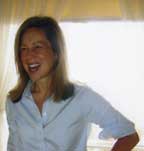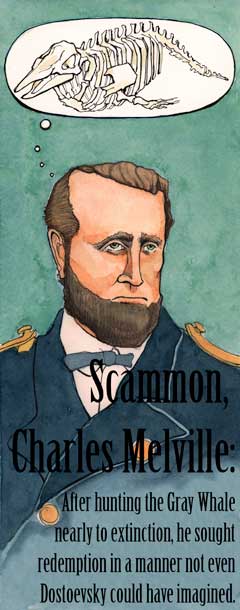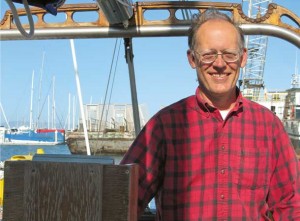San Francisco artist Eva Chrysanthe has always been intrigued by the Farallon Islands, those distant humps on the western horizon. “They’re enticing and forbidding and mysterious,” she explains. And then adds, “There are a ton of sharks out there.”
As a fourth-generation SF native, Chrysanthe takes pride in her knowledge of local history. She already knew about the egg-poaching that devastated seabird populations on the Farallones during the mid to late 19th century. The trade, thought to be dominated by criminal Italian immigrants, was so lucrative that competing companies and individuals squabbled over their claims on the islands.
“One day I started rattling off a standard response to a question about the islands and started to wonder,” says Chrysanthe. While fact-checking her own answer, Chrysanthe stumbled across a cache of old letters at the San Francisco History Center.
Eva discovered that blame for the egg-plundering had been erroneously placed on the shoulders of the “Mafiosos.”
“Egg company employee rosters revealed very few Italian names,” says Chrysanthe. “At the time of the egg wars, most of the Italians in San Francisco were Northern Italians, who had no connection with the Mafia.” Many of them were supporters of the revolutionary Giuseppe Garibaldi and his progressive agenda. “They were very cultured and educated. Many were merchant marines and had been all over the world.”
Extensive research at the San Francisco History Center, the Maritime Museum and the California Academy of Sciences also revealed that the Farallones, though 27 miles west of San Francisco, played a central role in the city’s early history.
“Almost immediately I wanted to do something with the material,” she says.
That something has turned out to be a full-length graphic novel called “Garibaldi and the Farallon Egg War.” She’ll be talking about the project this Thursday evening at the Randall Museum.
For Chysanthe, the graphic novel was the natural medium for this story. She has worked for several New York-based publications, including the New Yorker, as an illustrator. “It was really fun,” says Chrysanthe of her time with the New Yorker. “They’d send me out to draw what I saw, such as a mob funeral in Chinatown.”
But in her current project, Chrysanthe seeks more than to correct a historical misrepresentation. Egg harvesting climaxed in 1864 with a violent skirmish between the Pacific Egg Company and rivals who wished to stake a claim on the islands. The period of the Egg Wars coincided with the Gold Rush–a time of tremendous growth, as well as tremendous waste and destruction. The mining of seabird eggs was emblematic of this destruction, even as it literally helped to feed it.
“What struck me was their inability to plan,” says Chrysanthe. “They couldn’t figure out how to get chickens here, so they started poaching seabird eggs instead.” At one point, 500,000 eggs were taken in one two-month period. Populations of birds like the common murre were devastated.
Chrysnathe is careful to point out that even then there were people calling for protections.
“It wasn’t just poaching that was happening on the Farallones. There was a lot of amateur science.” She became intrigued with Charles Melville Scammon, a whaler from the East Coast. “Even as he was hunting gray whales to extinction, he was lovingly taking notes on their skeletal systems and habits,” says Chrysanthe.
It’s easy to look back on that period critically, she says, but the contradictions of the period intrigue her–and they remain relevant. “We think we’re so environmentally sophisticated,” she says “But I see a similar mentality at work today.”
Chrysanthe was in New York on September 11, 2001, but she moved back to San Francisco afterward: “I decided I’d rather die in California.”
But she didn’t immediately return to art. Instead, she wanted to do something hands-on and for three years she worked in the emergency room at UCSF (where she was born, incidentally).
“I was stunned by the last-minute approach,” she says. Many of the patients she saw were suffering from preventable diseases, yet the focus was on treating the symptoms and sending them home, an approach she compares to the one that drove the poaching at the Farallones.
She doesn’t see Gold Rush greed as a thing of the past, either.
“Our need for “much-ness” is too much,” Chrysanthe says. “We have big houses, big cars, big everything.”
For her own part, Chrysanthe chooses not to drive; in fact, she has never driven a car. When I spoke with her she was on an Amtrack train to Tahoe. The last time she went to the lake, she rode her bike.
Though Chrysanthe has worked on other graphic novel projects, this is her first full-length illustrated book. She trusts she will find a small, independent “niche” publisher to take on her project.
Eva Chrysanthe will be giving a lecture on the Farallon Egg Wars on Thursday, August 18th at the Randall Museum. To see more of Chrysanthe’s artwork and learn more about her project visit her blog at faralloneggwar.blogspot.com.

.jpg)





.jpg)